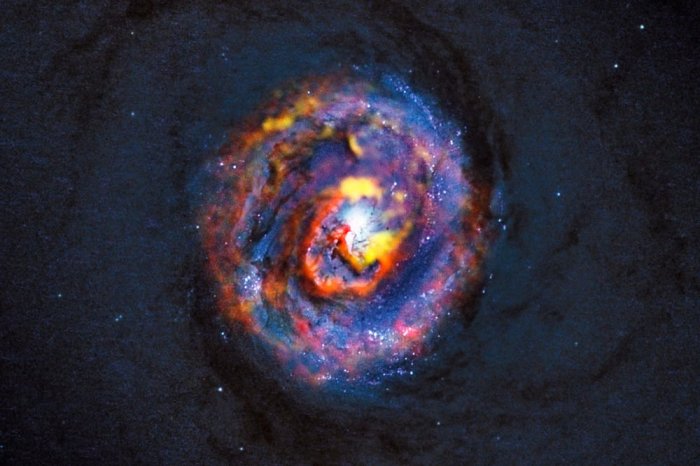Updated: Oct. 21, 2013 at 2:01 PM
2013: Year in Space (31 images)
A look back on the years's launches, space explorations and discoveries.

Photos released on October 16, 2013 by the European Southern Observatory (ESO) show how a black hole consumes hugh amounts of matter in studies released on galaxy PKS 1830-211 and NGC 1433. This photo shows NGC 1433 in a composite picture -- the dim blue background image showing the central dust lanes of this galaxy comes from the NASA/ESA Hubble Space Telescope, and the colored structures near the center are from recent ALMA (Atacama Large Millimeter/submillimeter Array) observations that have revealed a spiral shape, as well as an unexpected outflow, for the first time. This explains how the material is flowing in to fuel the black hole. ALMA is in Chile. SEE ALSO WAX201310102 and 103). UPI
License photo | Permalink

In this rendition released by NASA on Aug.29th, 2013, thew artist illustrates a supermassive black hole with millions to billions times the mass of our sun. Supermassive black holes are enormously dense objects buried at the hearts of galaxies. (Smaller black holes also exist throughout galaxies.) In this illustration, the supermassive black hole at the center is surrounded by matter flowing onto the black hole in what is termed an accretion disk. This disk forms as the dust and gas in the galaxy falls onto the hole, attracted by its gravity...Also shown is an outflowing jet of energetic particles, believed to be powered by the black hole's spin. The regions near black holes contain compact sources of high energy X-ray radiation thought, in some scenarios, to originate from the base of these jets. This high energy X-radiation lights up the disk, which reflects it, making the disk a source of X-rays. The reflected light enables astronomers to see how fast matter is swirling in the inner region of the disk, and ultimately to measure the black hole's spin rate. UPI
License photo | Permalink

Observations with NASA's Chandra X-ray Observatory have revealed a massive cloud of multimillion-degree gas in a galaxy about 60 million light years from Earth. The hot gas cloud is likely caused by a collision between a dwarf galaxy and a much larger galaxy called NGC 1232. If confirmed, this discovery would mark the first time such a collision has been detected only in X-rays, and could have implications for understanding how galaxies grow through similar collisions. An image combining X-rays and optical light shows the scene of this collision. The impact between the dwarf galaxy and the spiral galaxy caused a shock wave, akin to a sonic boom on Earth that generated hot gas with a temperature of about six million degrees. UPI/G. Garmire/NASA
License photo | Permalink

NASAÕs Hubble Space Telescope provides a close-up look of Comet ISON (C/2012 S1), on April 10,2013. At the time, the comet was slightly closer than JupiterÕs orbit at a distance of 386 million miles from the sun. The cometÕs dusty coma, or head of the comet, is approximately 3,100 miles across, or 1.2 times the width of Australia. A dust tail extends more than 57,000 miles, far beyond HubbleÕs field of view. ISON stands for International Scientific Optical Network, a group of observatories in ten countries who have organized to detect, monitor, and track objects in space. UPI/NASA/ ESA/ J.Y. Li
License photo | Permalink
Advertisement